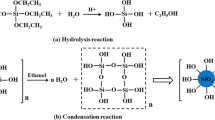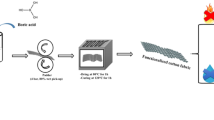Abstract
Hybrid phosphorus-doped silica films have been prepared through sol–gel processes to enhance the thermal and fire stability of cotton. To this aim, 3-aminopropyltriethoxysilane and N,N,N′,N′,N″,N″-hexakis-methoxymethyl-[1,3,5]triazine-2,4,6-triamine have been reacted with diethylphosphatoethyltriethoxysilane. FT-IR spectroscopy was exploited for assessing the formation of the silica skeleton on the cotton surface and for evaluating the interactions between the cellulosic fibres and the doped film. The effect of the concurrent presence of Si, P and N on cotton has been investigated by thermogravimetric analyses and the flammability behaviour has been assessed by vertical flammability tests, as well. The sol–gel treatments in the presence of phosphorus and nitrogen turned out to play a protective role on the degradation of the cotton fibres, hindering the formation of volatile species that fuel the further degradation and favouring the formation of a carbonaceous structure.








Similar content being viewed by others
References
Brushlinsky NN, Sokolov SV, Wagner P, Hall JR. World fire statistics. Report No. 10. Centre of fire statistics, international association of fire and rescue service; 2006. www.ctif.org.
Kobes M, Groenewegen K. Consumer fire: European statistics and potential fire safety measures. Austrian Federal Ministry Labor, Social Affairs and Consumer Protection; 2009.
Frantzich H. A model for performance-based design of escape routes. Technical report, Department of Fire Safety Engineering, Lund Institute of Technology. Lund: Lund University; 1994.
Gann RG. Estimating data for the incapacitation of people by fire smoke. Fire Technol. 2004;40:201–7.
Horrocks AR. In: Heywood D, editor. Textile finishing. Bradford: Society of dyers and colourists; 2003. p. 214–50.
Bourbigot S. In: Horrocks AR, Price D, editors. Advances in fire retardant materials. Cambridge: Woodhead Publishing; 2008. p. 9–40.
Horrocks AR. Advances in fire retardant materials. In: Horrocks AR, Price D, editors. Cambridge: Woodhead Publishing; 2008, p. 159–187.
Weil ED, Levchik SV. Flame retardants in commercial use or development for textiles. J Fire Sci. 2008;26:243–81.
Cabrales L, Abidi N. On the thermal degradation of cellulose in cotton fibers. J Therm Anal Calorim. 2010;102:485–91.
Hu S, Hu Y, Song L, Lu H. The potential of ferric pyrophosphate for influencing the thermal degradation of cotton fabrics. J Therm Anal Calorim. doi:10.1007/s10973-011-1732-1.
Hribernik S, Smole MS, Kleinschek KS, Bele M, Jamnik J, Gaberscek M. Flame retardant activity of SiO2-coated regenerated cellulose fibres. Polym Degrad Stab. 2007;92:1957–65.
Cireli A, Onar N, Ebeouglugil MF, Kayatekin I, Kutlu B, Culha O, Celik E. Development of flame retardancy properties of new halogen-free phosphorous doped SiO2 thin films on fabrics. J Appl Polym Sci. 2007;105:3747–56.
Moafi HF, Shojaie AF, Zanjanki MA. Flame-retardancy and photocatalytic properties of cellulosic fabric coated by nano-sized titanium dioxide. J Therm Anal Calorim. 2011;104:717–24.
Yaman N. Preparation and flammability properties of hybrid materials containing phosphorous compounds via sol–gel process. Fiber Polym. 2009;10:413–8.
Chaing CL, Chang RC. Synthesis, characterization and properties of halogen-free flame retardant PMMA nanocomposites containing nitrogen/silicon prepared from the sol–gel method. Compos Sci Technol. 2009;16:637–44.
Chaing CL, Ma CCM. Synthesis, characterization and thermal properties of novel epoxy containing silicon and phosphorus nanocomposites by sol–gel method. Eur Polym J. 2002;38:2219–24.
Chaing CL, Wang FY, Ma CCM, Chang HR. Flame retardance and thermal degradation of new epoxy containing silicon and phosphorous hybrid ceramers prepared by the sol–gel method Polym. Degrad Stabil. 2002;77:273–8.
Liu YL, Chou CI. The effect of silicon sources on the mechanism of phosphorus–-silicon synergism of flame retardation of epoxy resins. Polym Degrad Stabil. 2005;90:515–22.
Liu YL, Wu CS, Chiu YS, Ho WH. Preparation, thermal properties, and flame retardance of epoxy–silica hybrid resins. J Polym Sci: Pol Chem. 2003;41:2354–67.
Yu D, Liu W, Liu Y. Synthesis, thermal properties, and flame retardance of phosphorus-containing epoxy–silica hybrid resins. Polym Compos. 2010;31:334–9.
Alongi J, Ciobanu M, Carosio F, Tata J, Malucelli G. Thermal stability and flame retardancy of polyester, cotton and relative blend textile fabrics subjected to sol–gel treatments. J Appl Polym Sci. 2011;119:1961–9.
Alongi J, Ciobanu M, Malucelli G. Sol-gel treatments for enhancing flame retardancy and thermal stability of cotton fabrics: optimization of the process and evaluation of durability. Cellulose. 2011;18:167–77.
Alongi J, Ciobanu M, Malucelli G. Cotton fabrics treated with hybrid organic–inorganic coatings obtained through dual-cure processes. Cellulose. 2011;18:1335–48.
Alongi J, Ciobanu M, Malucelli G. Novel flame retardant finishing systems for cotton fabrics based on phosphorus-containing compounds and silica derived from sol–gel processes. Carbohyd Polym. 2011;85:599–608.
Alongi J, Ciobanu M, Malucelli G. Sol-gel treatments on cotton fabrics for improving thermal and flame stability: effect of the structure of the alkoxysilane precursor. Carbohyd Polym. 2012;87:627–35.
Alongi J, Ciobanu M, Malucelli G. Thermal stability, flame retardancy and mechanical properties of cotton fabrics treated with inorganic coatings synthesized through sol-gel processes. Carbohyd Polym. doi:10.1016/j.carbpol.2011.10.032.
Brancatelli G, Colleoni C, Massafra MR, Rosace G. Effect of hybrid phosphorus-doped silica thin films produced by sol–gel method on the thermal behavior of cotton fabrics. Polym Degrad Stabil. 2011;96:483–90.
Rosace G, Massafra MR. Marking of cellulose yarn by vinyl monomer grafting. Text Res J. 2008;78:28–36.
Price D, Horrocks AR, Akalin M, Faroq AA. Influence of flame retardants on the mechanism of pyrolysis of cotton (cellulose) fabrics in air. J Anal Appl Pyrol. 1997;40(/41):511–24.
Acknowledgements
The authors would like to thank Eng. Marco Longhi and Dr. Mihaela Ciobanu for the technical support in preparing the sol–gel treated fabrics.
Author information
Authors and Affiliations
Corresponding author
Rights and permissions
About this article
Cite this article
Alongi, J., Colleoni, C., Rosace, G. et al. Thermal and fire stability of cotton fabrics coated with hybrid phosphorus-doped silica films. J Therm Anal Calorim 110, 1207–1216 (2012). https://doi.org/10.1007/s10973-011-2142-0
Received:
Accepted:
Published:
Issue Date:
DOI: https://doi.org/10.1007/s10973-011-2142-0




